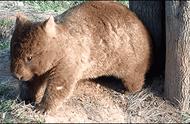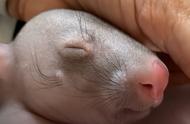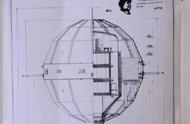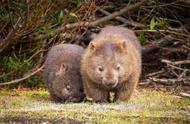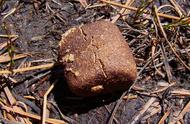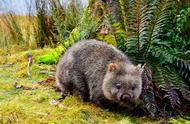如果你对可爱的袋熊有所了解,你会知道袋熊是地球上唯一能拉出方形便便的生物。多少年来,科学家一直无法弄明白袋熊为什么能拉出立方体的便便,而今他们终于找到答案了。

Despite having round anuses like all other mammals, bare-nosed wombats do not produce round pellets, tubular coils or messy piles; they are the only creature on Earth that poops cubes.
尽管和其他所有哺乳动物一样长着圆圆的肛门,但是毛鼻袋熊拉的便便却不是圆球状、螺旋状或乱糟糟的一堆,它们是地球上唯一拉方形便便的生物。
Wombats, marsupials native to the grassy plains and eucalyptus forests of Australia, are among the most adorable animals in the world, but to animal experts they have been a tough-to-solve mystery for a very long time. And it has all been because of their poop. You see, bare-nosed wombats have the unique ability to produce up to 100 distinctive, cuboid pieces of poop every day. Now, researchers say they have uncovered how the wombat intestine creates this unusually-shaped excrement.
居住在澳大利亚草原和桉树林里的有袋哺乳动物袋熊是世界上最可爱的动物之一,但是很长时间以来它们对于动物专家来说都是难解的谜。这都是因为它们拉的便便。要知道,毛鼻袋熊拥有一项独特能力,每天都能拉多达100个与众不同的立方体便便。现在,研究人员声称他们已经找到了袋熊便便如此特别的原因。

Researchers at Georgia Institute of Technology first started studying the wombat’s ability to poop cubes back in 2018, by analyzing the digestive tracts of wombats involved in car accidents. They compared the marsupial’s intestines to those of pigs, by inserting a balloon into the animals’ digestive tracts to see how it stretched to fit the balloon, and found regions of varied thickness and stiffness.
乔治亚理工学院的研究人员从2018年开始通过分析死于车祸的袋熊的消化道来研究袋熊为什么能拉方形便便。他们将袋熊的肠道和猪的肠道做了比较,将一个气球塞进两种动物的消化道,观察消化道为了容纳气球是如何伸缩的,结果发现不同区域的厚度和硬度都不同。
Scientists then created a 2D mathematical model to simulate how these intestine regions contract and expand with the rhythms of digestion, over multiple days, shaping the poop into its cuboid shape. Softer intestinal regions squeeze slowly and mold the final corners of the cube, researchers found. Interestingly, in most mammals, the contractions of intestinal muscles occur in all directions, but in wombats, the grooved tissue and irregular contractions shape the poop differently.
接下来,科学家创建了一个平面数学模型来模拟袋熊肠道各区域是怎样随着消化的节奏收缩和扩张并经过数天时间将便便塑造成立方体的。研究人员发现,比较柔软的肠道区域会缓慢收缩并给便便塑形。有趣的是,大多数哺乳动物的肠道肌肉都是向各个方向收缩,但是袋熊带纹路的肠道肌肉组织和不规则的收缩方式却将便便塑造成了不同的形状。

While this research may seem completely meaningless, or just meant to satisfy human curiosity, the scientists involved in the study say that these new revelations could have a big impact on human digestive health research and manufacturing technology. It would be a cool method to apply to the manufacturing process, how to make a cube with soft tissue instead of just molding it.
尽管这项研究也许看起来毫无意义,或者只是为了满足人类的好奇心,但是参与该研究的科学家表示,这些新发现可能对人类消化健康研究和制造技术产生重大影响。通过柔软的材料来塑造立方体而不是用模具来铸造,将这种方式应用于制造过程将会是一个很不错的方法。
Now that the mystery of how bare-nosed wombats produce cubical poop seems to have been solved, that only leaves the ‘why’. Scientists have some theories about this as well. One states that because wombats pick up their poop and stack it as a way of communicating between them, the cubicle shape helps them build higher poop towers.
毛鼻袋熊拉出方形便便的谜题既然已经解开,现在只剩下一个问题:为什么袋熊要拉方形便便?关于这个问题,科学家也有几种理论。其中一种理论指出,因为袋熊会捡拾自己的便便堆起来,以这种方式来和同类交流,立方体形状有助于它们将便便堆成“高塔”。

Another theory claims that because wombats tend to use their poop to mark their territory on rocks and logs, the cubical shape of the excrement ensures that it won’t simply roll off.
另一种理论指出,因为袋熊倾向于在石头和原木上用自己的便便来划分彼此的领地,立方体形状的便便不会从石头和原木上滚下去。
Also fun fact, the poop of wombats in captivity isn’t as cubic as that of wild ones. The squarer the poop, the healthier the wombat, apparently.
还有一个有趣的事实是,圈养袋熊的便便不像野生袋熊的便便那么方。显然,便便越方,袋熊越健康。
栏目主编:张武 文字编辑:卢晓川 题图来源:IC photo 图片编辑:曹立媛
来源:作者:中国日报
,